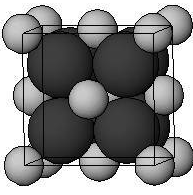
Sodium oxide ${ Na }_{ 2 }{ O }$ is a crystalline solid, it has:
A. Anti fluorite structure
B. ${ Na }^{ + }$ ions are present at body diagonals
C. ${ Na }^{ + }$ ions are present at tetrahedral voids
D. ${ O }^{ 2- }$ ions are present at octahedral voids
Answer
483.6k+ views
Hint: A crystal or crystalline solid is a solid material whose constituent atoms, molecules, or ions are arranged in an orderly, repeating pattern extending in all three spatial dimensions. In crystallography, an anti-fluorite structure is acquired from a salt structure by exchanging anion and cation positions.
Complete step by step answer:
In the antifluorite structure, the anions adopt a face-centered cubic arrangement with cations in the tetrahedral interstices. The cations have a coordination number of 4 and the anions have a coordination number of 8.

Figure: Cations are shown by black atoms and anions are shown by grey atoms.
In sodium oxide ${ Na }_{ 2 }{ O }$, ${ Na }^{ + }$ ions are present at tetrahedral voids and ${ O }^{ 2- }$ ions occupy half of the cubic holes in the face cubic close lattice. ${ Na }^{ + }$ ions are present at body diagonals.
${ Na }_{ 2 }{ O }$ is an anti fluorite structure.
Hence, the correct answer is option A,B,C.
Additional Information
a.)Voids or interstitial spaces are the gaps present between various spheres of a crystalline solid.
b.)The tetrahedral void is formed when a particle in the second layer is above a void of the first layer.
c.)The octahedral void is formed when a void of the second layer is above the void of the first layer.
d.)There are twice the same number of octahedral gaps as there are tetrahedral openings, in a cross-section.
e.)Body-centered unit cell: When the lattice points are present at the eight corners of the unit cell as well as an additional point at the centre of the cell.
Note:
The possibility to make a mistake is that you may not choose option B. But ${ Na }^{ + }$ ions are present at body diagonals, not on face diagonals.
Complete step by step answer:
In the antifluorite structure, the anions adopt a face-centered cubic arrangement with cations in the tetrahedral interstices. The cations have a coordination number of 4 and the anions have a coordination number of 8.

Figure: Cations are shown by black atoms and anions are shown by grey atoms.
In sodium oxide ${ Na }_{ 2 }{ O }$, ${ Na }^{ + }$ ions are present at tetrahedral voids and ${ O }^{ 2- }$ ions occupy half of the cubic holes in the face cubic close lattice. ${ Na }^{ + }$ ions are present at body diagonals.
${ Na }_{ 2 }{ O }$ is an anti fluorite structure.
Hence, the correct answer is option A,B,C.
Additional Information
a.)Voids or interstitial spaces are the gaps present between various spheres of a crystalline solid.
b.)The tetrahedral void is formed when a particle in the second layer is above a void of the first layer.
c.)The octahedral void is formed when a void of the second layer is above the void of the first layer.
d.)There are twice the same number of octahedral gaps as there are tetrahedral openings, in a cross-section.
e.)Body-centered unit cell: When the lattice points are present at the eight corners of the unit cell as well as an additional point at the centre of the cell.
Note:
The possibility to make a mistake is that you may not choose option B. But ${ Na }^{ + }$ ions are present at body diagonals, not on face diagonals.
Recently Updated Pages
Master Class 12 Economics: Engaging Questions & Answers for Success

Master Class 12 Maths: Engaging Questions & Answers for Success

Master Class 12 Biology: Engaging Questions & Answers for Success

Master Class 12 Physics: Engaging Questions & Answers for Success

Master Class 12 Business Studies: Engaging Questions & Answers for Success

Master Class 12 English: Engaging Questions & Answers for Success

Trending doubts
Which are the Top 10 Largest Countries of the World?

Differentiate between homogeneous and heterogeneous class 12 chemistry CBSE

Draw a labelled sketch of the human eye class 12 physics CBSE

What is the Full Form of PVC, PET, HDPE, LDPE, PP and PS ?

What is a transformer Explain the principle construction class 12 physics CBSE

What are the major means of transport Explain each class 12 social science CBSE




